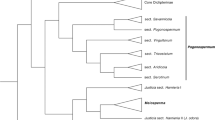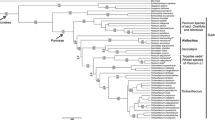Abstract
A survey is given of three natural groups of the subsectionHeterophylla (Witas.)Fed. of the genusCampanula L. Within theSaxicolae four taxa of higher rank have been revealed:c. xylocarpa Kovanda (2n=34),C. gentilis Kovanda (2n=34),C. moravica (Spitzner)Kovanda subsp.moravica (2n=68), andC. moravica subsp.xylorrhiza (O. Schwarz)Kovanda (2n=102). BothAlpicolae andLanceolatae are represented by a single species: the first byC. cochleariifolia Lam. (2n=34), the latter byC. serrata (Kit. ap.Schult.)Hendrych (2n=34). Cytology, ecology and geographical distribution of all these taxa have been reviewed, and relationships to the other members of the complex discussed. Infraspecific variation within each species has also been examined.
Similar content being viewed by others
Literature Cited
Bielawska, H. (1964): Cytogenetic relationships between lowland and montane species ofCampanula rotundifolia L. group I. C.cochleariifolia Lam. andC. rotundifolia L.—Acta Soc. Bot. Polon., Warszawa, 33: 15–44.
Böcher, T. W. (1960): Experimental and cytological studies on plant species V. TheCampanula rotundifolia complex.—Biol. Skr. Dan. Vid. Selsk., Copenhagen, 11/4: 1–69.
Čelakovský, L. (1870): Květena okolí Pražského.—Praha.
Čelakovský, L. (1871): Produromus der Flora von Böhmen 2.—Prag.
Čelakovský, L. (1879): Analytická květena česká.—Praha.
Davis, P. H. etHeywood, V. H. (1963): Principles of Angiosperm taxonomy.—Edinburgh and London.
Degen, Á. (1938): Flora velebitica 3.—Budapest.
Domin, K. (1904): České Středohoří. Studie fytogeografická.—Praha.
Domin, K. (1928): The relations of the Tatra mountain vegetation to the edaphic factors of the habitat.—Acta bot. both., Praha, 6–7: 133–164.
Domin, K. (1932): Nejvýznačnější travinná společenstva Čachtických kopců v jihozápadním Slovensku.—Rozpr. 2. Tř. čes. Akad., Praha, 42/24: 1–10.
Domin, K. etPodpěra, J. (1928): Klíč k úplné květeně Republiky československé.—Olomouc.
Dostál, J. (1954): Klíč k úplné květeně ČSR, ed. 1.—Praha.
Dostál, J. (1960): The phytogeographical regional distribution of the Czechoslovak flora. —Sborn. čs. Společ. zeměp., Praha, 65: 193–202.
Fedorov, A. A., (1957):Campanulaceae, inShishkin, B. K. etBobrov, E. G. (red.): Flora SSSR 24: 126–450.
Futák, J. (1943): Kremnické hory.—Turč. Sv. Martin.
Gadella, T. W. J. (1964): Cytotaxonomic studies in the genusCampanula.—Wentia, Amsterdam, 11: 1–104.
Gauckler, K. (1938): Steppenheide und Steppenheidewald der Fränkischen Alb in pflanzensoziologischer, ökologischer und geographischer Betrachtung.—Ber. Bayr. bot. Ges., München, 23: 1–134.
Günther, K. C., Grabowski, H. etWimmer, F. (1824): Enumeratio stirpium phanerogamarum quae in Silesia proveniunt.—Vratislaviae.
Hayek, A. (1918):Campanula, inHegi, G.: Illustrierte Flora von Mitteleuropa 6/1: 330–365.
Hegetschweiler, J. (1840): Flora der Schweiz.—Zürich.
Hendrych, R. (1950):Campanulaceae, inDostál, J. et al.: Květena ČSR, p. 1418–1436.
Hendrych, R. (1962):Thesium contraCampanulam.—Taxon, Utrecht, 11: 122–123.
Holur, J., Hejný, S., Moravec, J. etNeuhäusl, R. (1967): Übersicht der höheren Vegetationseinheiten der Tschechoslowakei.—Rozpr. čs. Akad. Věd, Praha, ser. math.-natur., 77/3: 1–75.
Hruby, J. (1930): Campanulastudien innerhalb derVulgares und ihrer Verwandten.—Magy. bot. Lap., Budapest, 29: 152–276.
Jenny-Lips, H. (1930): Vegetationsbedingungen und Pflanzengesellschaften auf Felsschutt. —Beih. bot. Cbl., Dresden, 46: 119–296.
Jordan, A. (1852): Pugillus plantarum novarum praesertim gallicarum.—Paris.
Klika, J. (1926): Poznámky ke geobotanickému výzkumu Velké Fatry.—Sborn. přírod. Společ. Mor. Ostrava 3: 38–85.
Klika, J. (1932): DerSeslerion coeruleae-Verband in den West-Karpathen.—Beih. bot. Cbl., Dresden, 49: 133–175.
Klika, J. (1936): Studien über die xerotherme Vegetation Mitteleuropas IV.—Erläuterung zur vegetationskundlichen Karte des Lovoš (Lobosch).—Beih. bot. Cbl., Dresden, 54: 489–514.
Klika, J. (1940): Zur Kenntnis der Waldgesellschaften im Böhmischen Mittelgebirge.— Beih. bot. Cbl., Dresden, 60: 249–286.
Klika, J. (1955): Nauka o rostlinných společenstvech.—Praha.
Koch, W. D. J. (1902): Synopsis der deutschen und schweizer Flora 2.—Leipzig.
Kovanda, M. (1966):Campanula xylocarpa—a new species of the seriesSaxicolae Witasek.— Folia geobot. phytotax., Praha, 1: 176–185.
Kovanda, M. (1967): RozmieszczenieCampanula serrata (Kit. ap.Schult.)Hendrych w Karpatach Zachodnich.—Fragm. flor. geobot., Kraków, 13: 3–10.
Kovanda, M. (1968): New taxa and combinations in the subsectionHeterophylla (Witas.)Fed. of the genusCampanula L.—Folia geobot. phytotax., Praha, 3: 407–411.
Kovanda, M. (1970): Polyploidy and variation in theCampanula rotunidifolia complex. Part I. (General).—Rozpr. čs. Akad. Věd, Praha, ser. math.-natur., 80/2: 1–95.
Löve, Á. etLöve, D. (1961): Chromosome numbers of Central and Northwest European plant species.—Opera bot., Lund, 5: 1–581.
Mertens, F. K. etKoch, W. D. J. (1826): Deutschlands Flora.
Mikyška, R. (1936): Ekologická a sociologická studia pastvin vápencové a dolomitové Západokarpatské hornatiny (Čachtické kopce).—Sborn. čs. Akad. zeměd., Praha, 11: 445–453.
Morariu, I. (1964): SectiaV. Linophylloides Schur, inSâvulescu, T. et al.: Flora Republicii populare Romîne 9: 86–111.
Oberdorfer, E. (1957): Süddeutsche Pflanzengesellschaften.—Pflanzensoziologie, Jena, 10: 1–564.
Opiz, P. M. (1831): Nomenclator botanicus.—Prag.
Opiz, F. M. (1852): Seznam rostlin květeny české.—Praha.
Pacyna A. etPiekoś H. (1968): RozmieszczenieCampanula serrata (Kit. ap.Schult.)Hendrych w Polsee.—Fragm. flor. geobot., Kraków, 14: 229–235.
Pawłowski, B. (1956): Flora Tatr 1.—Warszawa.
Pax, F. (1908): Grundzüge der Pflanzenverbreitung in den Karpathen 2.—Veget. d. Erde 10: 1–322.—Leipzig.
Podlech, D. (1962): Beitrag zur Kenntnis der SubsektionHeterophylla (Witas.)Fed. der GattungCampanula L.—Ber. deutsch. bot. Ges., Berlin, 75: 237–244.
Podlech, D. (1965): Revision der europäischen und nordafrikanischen Vertreter der Subsect.Heterophylla (Wit.)Fed. der GattungCampanula L.—Feddes Rep., Berlin, 71: 50–187.
Podlech, D. etDamboldt, J. (1964): Zytotaxonomische Beiträge zur Kenntnis derCampanulaceen in Europa.—Ber. deutsch. bot. Ges., Berlin, 76: 360–369.
Preis, K. (1939): DieFestuca valesiaca—Erysimum crepidifolium—Assoziation auf Basalt, Glimmerschiefer und Granitgneis.—Beih. bot. Cbl., Dresden, 50: 478–530.
Prodan, I. (1923): Flora pentru determinarea si deserierea plantelor ce cresce in România.—Cluj.
Rothmaler, W. (1963): Exkursionsflora von Deutschland. Kritischer Ergänzungsband.—Berlin.
Sâvulescu, T. (1916): Studiu asupra speciilor deCampanula L. din sec⋆ia “Heterophyllae”, ce cresc în România.—Teze prezentate Facultâ⋆ei de Ştiin⋆e din Bucure§ti 11: 1–100.
Schott, H., Nyman, C. F. etKotschy, T. (1854): Analecta botanica 1.—Vindobonae.
Schur, F. (1866): Enumeratio plantarum Transsilvaniae.—Vindobonae.
Sillinger, P. (1931): Vegetace Tematínských kopců na západním Slovensku. Příspěvek k fytogeografii a fytosociologii vápencových obvodů v jihozápadních výběžcích karpatských. —Rozpr. 2. Tř. čes. Akad. Praha, 40/13: 1–46.
Sillinger, P. (1933): Monografická studie o vegetaci Nízkých Tater.—Praha.
Skaliňska, M., Pogan, E. et al. (1966): Further studies in chromosome numbers of Polish Angiosperms (sixth contribution).—Acta biol. cracov., Kraków, 9: 31–58.
Spitzner, V. (1893): Floristische Mittheilunge.—Verh. naturforsch. Ver. Brünn, Brünn, 31: 193–200.
Sugiura, T. (1940): A list of chromosome numbers in angiospermous plants VI.—Proc. Imp. Acad. Tokyo, Tokyo, 16: 15–16.
Sugiura, T. (1942): Studies in the chromosome numbers inCampanulaceae. I.Campanuloideae— Campanuleae.—Cytologia, Tokyo, 12: 418–434.
Szafer, W., Kulczńyski, S. etPawłowski, B. (1924): Rośliny polskie.—Lwów et Warszawa.
Szafer, W., Kulczńyski, S. etPawłowski, B. (1953): Rośliny polskie, ed. 2.—Warszawa.
Šimr, J. (1930): Poznámky ke květeně skal na Koštálu.—Věda přír., Praha, 11: 85–86.
Šimr, J. (1931): Vegetace na drolinách Milešovského středohoří.—Věda přír., Praha, 12: 92–101.
Šimr, J. (1948): Borečský vrch—přírodní památka botanicko-geologická.—Ochrana Přírody, Praha, 3: 36–42.
Visjulina, O. D. (1961): Rodina CXXXVII. Dzvonikovi—Campanulaceae, inKotov, M. I. et al.: Flora URSR 10: 399–452.
Vollmann, F. (1914): Flora von Bayern.—Stuttgart.
Wimmer, F. (1840): Flora von Schlesien preussischen und österreichischen Anteils.—Breslau, Ratibor und Pless.
Wimmer, F. etGrabowski, H. (1827): Flora silesiaca 1.—Vratislaviae.
Witasek, J. (1902): Ein Beitrag zur Kenntnis der GattungCampanula.—Abh. zool. bot. Ges. Wien, Wien, 1/3: 1–106.
Witasek, J. (1906): Studien über einige Arten aus der Verwandtschaft derCampanula rotundifolia L.—Magy. bot. Lap., Budapest, 5: 236–249.
Author information
Authors and Affiliations
Rights and permissions
About this article
Cite this article
Kovanda, M. Polyploidy and variation in theCampanula rotundifolia complex. Part II. (Taxonomic) I. Revision of the groupsSaxicolae, Lanceolatae andAlpicolae in Czechoslovakia and adjacent regions. Folia geobot. phytotax. 5, 171–208 (1970). https://doi.org/10.1007/BF02851825
Received:
Issue Date:
DOI: https://doi.org/10.1007/BF02851825




